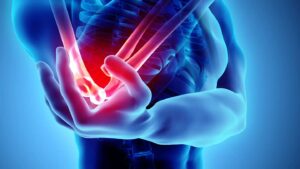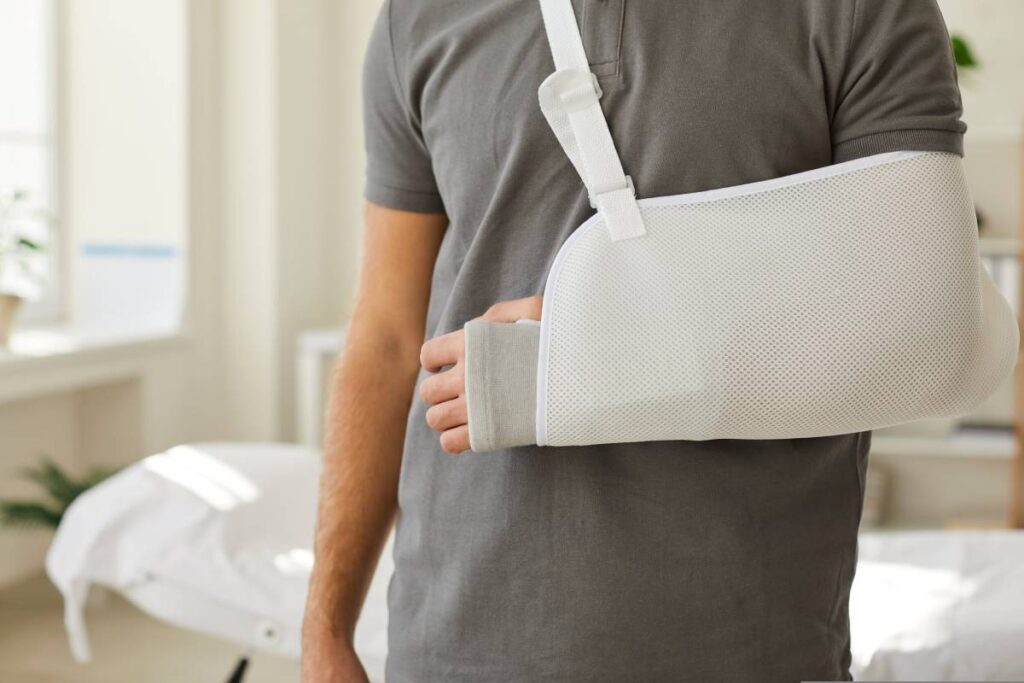Do you find it painful to lift your groceries, bend your arm, or even shake hands? Elbow pain can be more than just an inconvenience—it can disrupt your everyday life and activities. Whether it’s due to an injury, repetitive movements, or age-related wear and tear, elbow pain is something many of us experience.
In this blog, we’ll explore how orthopedic doctors diagnose and treat elbow pain and when you should consider seeing one for the best results. Keep reading to find out how you can get the relief you need and start living pain-free!
Contents
What Causes Elbow Pain?
 Elbow pain can stem from a variety of causes, affecting the muscles, tendons, or joints. Here are some of the most common causes:
Elbow pain can stem from a variety of causes, affecting the muscles, tendons, or joints. Here are some of the most common causes:
-
Tennis Elbow (Lateral Epicondylitis)
This condition occurs due to overuse or repetitive movements, especially in activities like tennis, hence the name. It affects the outer part of the elbow and causes pain and tenderness when gripping or lifting objects. -
Golfer’s Elbow (Medial Epicondylitis)
Similar to tennis elbow, golfer’s elbow affects the inner side of the elbow. It’s caused by repetitive stress from activities that involve swinging motions, such as golfing, and can cause pain on the inner elbow and forearm. -
Arthritis
Arthritis leads to joint inflammation, stiffness, and pain, especially during movement. -
Fractures
A fracture or broken bone in the elbow can lead to severe pain, swelling, and limited movement. -
Bursitis
Bursitis happens when the small fluid-filled sacs (bursae) around the elbow become inflamed due to repetitive motion or injury. -
Tendonitis
In the elbow, it can affect the tendons connecting the forearm muscles to the elbow joint, leading to pain and difficulty with movement. -
Cubital Tunnel Syndrome
This occurs when the ulnar nerve (the “funny bone” nerve) becomes compressed, causing tingling, numbness, and pain in the elbow and hand, especially when bending the elbow for long periods.
Understanding the cause of elbow pain is the first step to finding the right treatment. If your pain is persistent or worsens, it’s time to consult an orthopedic doctor who can diagnose the underlying issue and guide you toward the most effective treatment options.
How an Orthopedic Doctor Diagnoses Elbow Pain
 When you visit an orthopedic doctor for elbow pain, the first step will be a physical examination. The doctor will check for any visible signs of swelling, bruising, or deformities. They’ll also test your range of motion by asking you to move your arm in various ways to see which movements cause pain or discomfort.
When you visit an orthopedic doctor for elbow pain, the first step will be a physical examination. The doctor will check for any visible signs of swelling, bruising, or deformities. They’ll also test your range of motion by asking you to move your arm in various ways to see which movements cause pain or discomfort.
Once the physical exam is done, the orthopedic doctor will often recommend X-rays to assess the bones in your elbow. X-rays are helpful in identifying any fractures, joint degeneration, or signs of arthritis. If the doctor suspects damage to soft tissues, such as ligaments, tendons, or cartilage, they may suggest an MRI (Magnetic Resonance Imaging). MRIs provide detailed images of the soft tissues and can reveal issues like tendonitis, tears, or inflammation in the elbow area.
In some cases, the orthopedic specialist may also suggest ultrasound imaging to see real-time movement and assess soft tissue injuries. If nerve involvement is suspected, tests like nerve conduction studies may be done to evaluate the function of the nerves in the elbow and arm.
By combining these diagnostic tools with the details from your physical exam, the orthopedic doctor can pinpoint the exact cause of your elbow pain. Once the diagnosis is clear, they can then recommend the appropriate treatment to relieve your pain and restore mobility.
Non-Surgical Treatments for Elbow Pain

If you’re experiencing elbow pain, there are several non-surgical treatments that can provide significant relief and help manage your symptoms effectively. Here’s how you can treat your elbow pain without surgery:
-
Physical Therapy
-
A physical therapist can guide you through specific exercises designed to strengthen the muscles around the elbow, improve flexibility, and reduce pain. Therapy helps restore movement and prevents further injury, especially in conditions like tendonitis or arthritis.
-
-
Medications
-
Over-the-counter pain relievers, such as NSAIDs (e.g., ibuprofen), can help reduce inflammation and alleviate pain. For more intense discomfort, a doctor might prescribe stronger medications or steroid injections to reduce inflammation and provide short-term relief.
-
-
Ice and Heat Therapy
-
Ice packs applied to the elbow can help reduce swelling and numb the pain, particularly after physical activity or an injury. On the other hand, heat therapy, like warm compresses, can help soothe stiff muscles and joints, improving blood flow and flexibility.
-
-
Rest
-
Giving your elbow enough rest is crucial for healing. Avoiding activities that strain the elbow, such as lifting heavy objects or repetitive movements, helps to prevent further injury. Resting also gives your muscles and tendons the time they need to recover and repair.
-
-
Bracing or Splinting
-
For conditions like tennis elbow or golfer’s elbow, wearing a brace or splint can support the elbow, reducing stress on the affected areas and promoting healing.
-
These non-surgical treatments can be very effective in managing elbow pain, especially when combined with lifestyle adjustments and regular follow-ups with an orthopedic doctor. If you’re dealing with persistent or worsening elbow pain, consulting an orthopedic specialist can help you explore these options and find the best solution for your recovery.
Surgical Treatments for Elbow Pain

While most elbow pain can be managed with non-surgical methods, surgery may be needed when the condition is severe, doesn’t improve with conservative treatment, or involves serious damage.
Here’s when surgery becomes an option — and what it typically involves:
When Is Surgery Needed?
Surgery is usually recommended for:
- Elbow fractures that cannot heal properly on their own
- Severe ligament or tendon tears (such as in athletes)
- Chronic tendonitis or bursitis that doesn’t respond to rest, therapy, or medications
- Arthritis or bone spurs that significantly limit movement or cause persistent pain
Common Elbow Surgeries
- Arthroscopy: A minimally invasive surgery using a small camera to remove damaged tissue, repair cartilage, or clean the joint.
- Tendon Repair: Involves reattaching torn tendons in conditions like tennis elbow if the tendon is severely damaged.
- Fracture Repair: Uses metal plates, screws, or pins to stabilize broken bones and allow them to heal correctly.
- Joint Replacement: In rare and extreme cases (especially with advanced arthritis), the elbow joint may be replaced with an artificial one.
Most elbow surgeries are safe and effective, and with proper rehabilitation, many patients regain full or near-full use of their arm. If you’re experiencing pain that doesn’t improve or interferes with daily life, it’s important to consult an orthopedic surgeon to explore surgical options tailored to your specific condition.
Exercises and Stretches to Relieve Elbow Pain

Here are some simple exercises and stretches you can do at home to help reduce elbow pain and improve mobility:
Wrist Flexor Stretch
-
-
How to do it: Extend one arm with the palm facing up. Gently pull your fingers back towards your body with your other hand.
-
Hold for: 20-30 seconds.
-
Why it helps: Reduces tension in the forearm muscles and alleviates elbow discomfort.
-
Triceps Stretch
-
-
How to do it: Raise one arm overhead and bend your elbow, reaching your hand towards your back. Use your other hand to push your elbow for a deeper stretch.
-
Hold for: 20-30 seconds.
-
Why it helps: Relieves tension in the triceps, which can reduce elbow pain.
-
Elbow Flexion and Extension
-
-
How to do it: Sit with your arm resting by your side. Bend your elbow slowly, bringing your hand towards your shoulder, then straighten it back out.
-
Repeat: 10-15 times.
-
Why it helps: Improves the range of motion and reduces elbow stiffness.
-
Forearm Supination and Pronation
-
-
How to do it: Hold a light object in your hand with your elbow bent at 90 degrees. Rotate your forearm so your palm faces up (supination) and down (pronation).
-
Repeat: 10-15 times.
-
Why it helps: Strengthens muscles around the elbow and improves rotation.
-
Tennis Elbow Stretch
-
-
How to do it: Extend your arm with the palm facing down. Gently pull your fingers back towards your body with your other hand.
-
Hold for: 20-30 seconds.
-
Why it helps: Targets the muscles inflamed in tennis elbow, providing relief.
-
Regularly performing these exercises and stretches can help reduce pain, increase flexibility, and promote healing. Always perform them gently and stop if you feel sharp pain. If the pain continues, consider consulting an orthopedic specialist for further evaluation.
How to Prevent Elbow Pain
 Here are some helpful tips to prevent elbow pain and keep your joints healthy:
Here are some helpful tips to prevent elbow pain and keep your joints healthy:
- Ensure you use proper posture and technique while lifting, typing, or performing repetitive tasks to avoid unnecessary strain on the elbow.
- If you’re performing repetitive tasks, such as typing or using a mouse, take regular breaks to rest and stretch your elbow.
- Perform exercises to strengthen the muscles around your elbow to provide better support and reduce the risk of strain or injury
- Avoid overexertion
- If you’re involved in sports, use protective gear like elbow pads to prevent injury and strain on the joint.
- Maintain a healthy weight
- Use ergonomic equipment at work, such as an adjustable chair and keyboard, to reduce strain on your elbows during tasks like typing or computer use.
- Stretch your forearm and wrist muscles regularly to keep the elbow joint flexible and prevent stiffness.
By following these tips, you can significantly reduce the risk of elbow pain and keep your joints functioning well for a long time.
Where to Find an Orthopedic Doctor for Elbow Pain
If you’re experiencing persistent elbow pain or discomfort that doesn’t improve with home remedies, it’s important to consult an orthopedic specialist for a proper diagnosis and treatment plan.
At MantraDoc, we connect you with qualified orthopedic specialists who can help diagnose and treat your elbow pain online. Whether it’s through simple advice, a treatment plan, or further referrals, our platform ensures you get the best care tailored to your needs.
👉 Click here to book your online consultation with an orthopedic specialist today!
Consulting an orthopedic doctor is the best step toward finding long-term relief from your elbow pain, and MantraDoc makes it simple and accessible. Don’t wait—take charge of your health today!

